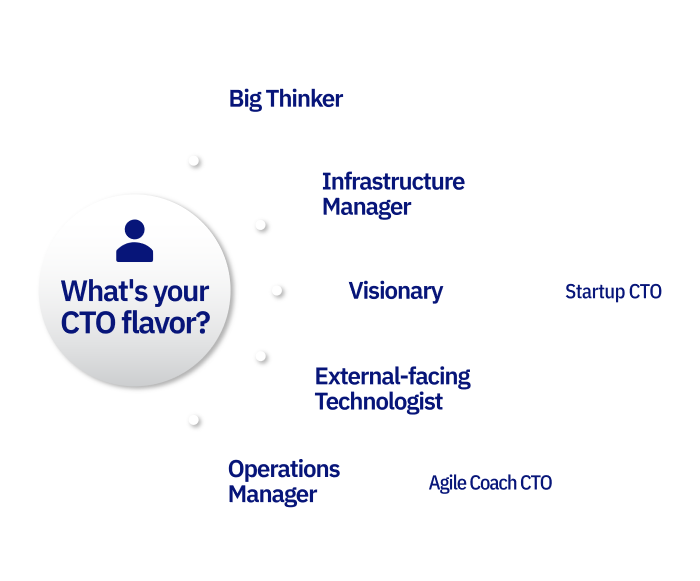Introduction
When it comes to assessing what kind of CTO you are, you are probably well aware that individuals sitting within the top echelons of technology management don’t come from the same mould.
At Pentalog, we have seen the role of CTO evolve considerably over the years. Working with such a vast range of CTOs allows us to understand the differences, which we have listed out below. We believe understanding what kind of CTO you are helps unlock the secrets of success. Not only ensuring your role matches your palate but also satisfies your appetite for growth.
To help you discover your flavor, we’ve created ‘CTO Assessment for Growth’ – a helpful assessment to uncover what traits determine your perfect fit as a CTO.
What CTO flavor are you?
Big Thinker CTO
This type of CTO is much more focused on the strategic aspects of the company. The way technology is used by the company creates competitive advantage and becomes an important part of the value proposition. Big Thinkers are CTOs that enable new business models and business lines. They know how to conduct competitive analysis, technology assessment, technology or digitization schemes. They engage with partners and some of them have the role as CTO of big corporates or groups, leading technology roadmaps of subsidiaries or companies within the group.
Infrastructure Manager CTO
An Infrastructure Manager CTO will usually focus on business operational efficiency. TCO, costs analysis and productivity are second nature to them. They usually emerge from the infrastructure teams rather than software development. Compared with an Operations Manager CTO, an Infrastructure Manager CTO will keep practicing technology. They will have a preference for laboratories, technology leadership, infrastructure, and resources stewardship rather than real-life operational challenges with a focus on services, products, and customer relationships. This category of CTO is also a high enabler of technologies across all business units and departments.
The Visionary CTO
A Visionary CTO is usually the kind who knows everything in software services and products development. They play an important role in translating technology opportunities to the board and vice-versa, business opportunities to their teams. Excellence in both technology and business can make a real difference for a CTO role implementation. The Visionary CTO is also running the technology, so compared with external-facing CTOs, is accountable for implementation as well (not just for opportunities and risks refinement). It is common to find technical founders holding this position before their exit. The bigger the organization becomes, the less important it gets for the CTO to be a technical expert and handle sophisticated technical details. However, recruiting the right talent, evolving towards learning organization, organizing efficiently, and leveraging technology best practices remain infinitely harder constant challenges. The framework to setup such a scalable organization is in the body of CTO requirements through responsibilities like `governance`, `facilitate work` or `enhance agility`.
Startup CTO
While initially the CTOs were mainly focused on business strategy, people started to employ the CTO role in all sorts of situations. Even if the market moved far away from the initial value proposition of the CTO, we need to acknowledge that this population of CTOs exists and is large enough to designate its own cluster. Startup CTOs are usually experts in the product, they still code and lead engineering. Sometimes, they are the only engineer. The Startup CTO is not a CTO flavor, but a subset of Visionary CTO. Startup CTOs are usually a great fit for early-stages business development. One of the most important root-causes of their challenges is to not keep the pace with the fast-growing organization. Organizations moving forward in new stages of their lifecycle will quickly expect CTOs to adapt their decision-making framework and the overall positioning towards the executive management, technology teams and their direct beneficiaries.
External-Facing Technologist CTO
External-Facing Technologist CTOs are those providing a wide range of technology-related solutions for external customers. They are found in outsourcing companies, sometimes act as freelancers, and play critical advisory roles in consulting companies. Pentalog is a proud player in this field offering CTO services for customers. These CTOs usually have dedicated teams to benchmark and study technologies for early adoption, review libraries of best practices and make them actionable for customers and engage in various technology leadership tactics. Therefore, communication, interpersonal skills and the expertise of transferring knowledge to other organizations play a much more important role than in any other CTO flavor.
Operations Manager CTO
With a clear focus on processes, quality improvement, and the efficiency of the value stream as a whole, the Operations Manager CTO is looking at technology for opportunities to foster operational efficiency. They tend to expose themselves more to the customers to better represent them in the company and sometimes even handle an important part of customer relationships.
Agile Coach CTO
This is a new subset of Visionary or Operations Manager types of CTO. We clearly distinguish between the long-term success of an experienced agile practitioner that became a CTO and the less experienced ones. Agile is hard. The goal is to embrace change without suffering. These are places where agile practice makes a difference. These CTOs are less technical and rarely cofounded the company. Efficiency, cycle times, large-scale agile, and collaboration framework are their second language. They are usually the most requested kind of candidates to replace Startup CTOs unable to reposition themselves as efficient Visionaries when the company grows. CTOs lacking this experience complement their role with VP of Engineering/Engineering manager type of roles.
Latest Insights on Software Engineering & Product Development
Design Patterns
The Flyweight Chronicles: How to Make Your Code Weightless!

Design Patterns
Facade Design Pattern: Streamlining Complexity in Code

Tech Trends
Innovation in Practice: Navigating Through Proof of Concept, Prototypes, Pilots, and MVPs





